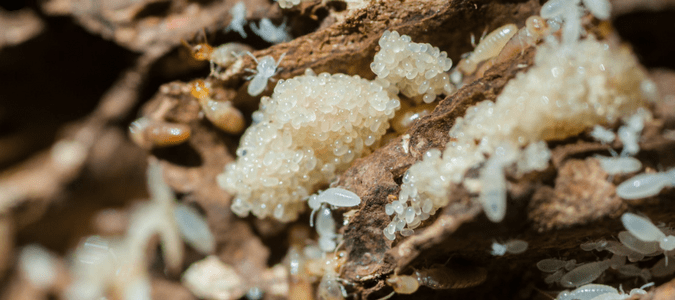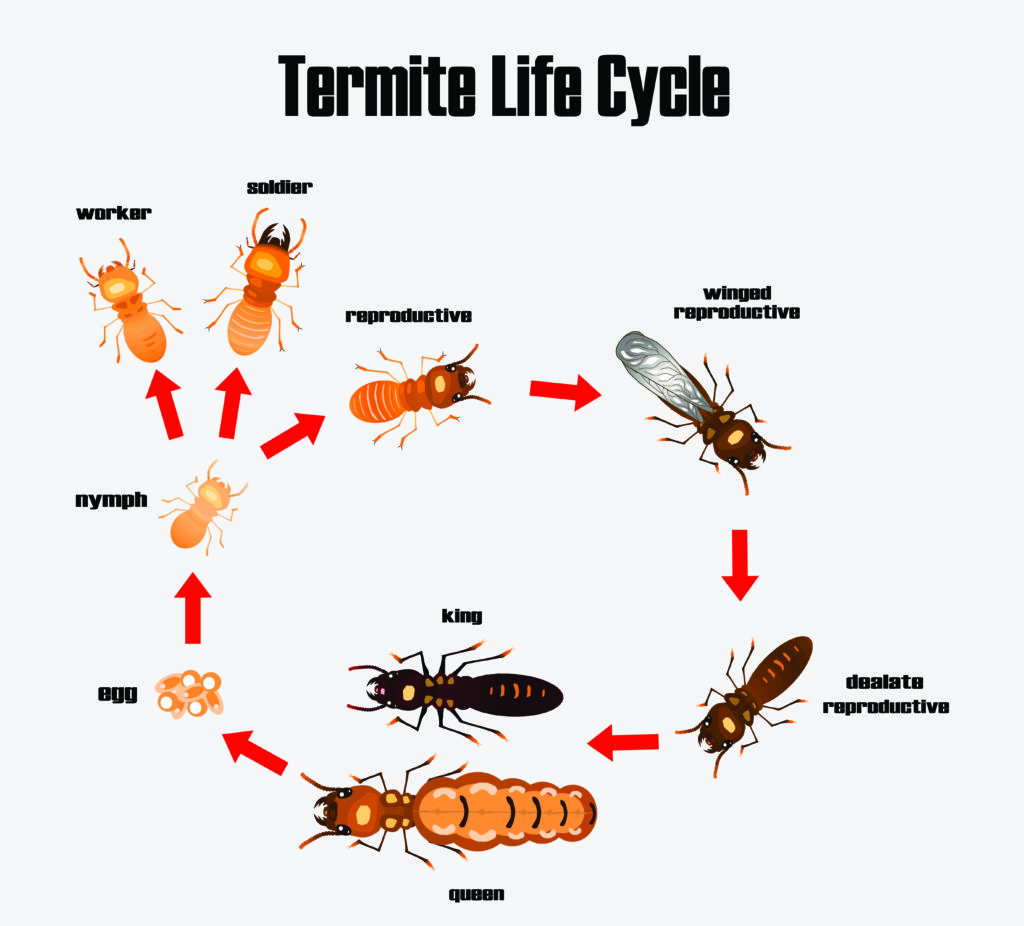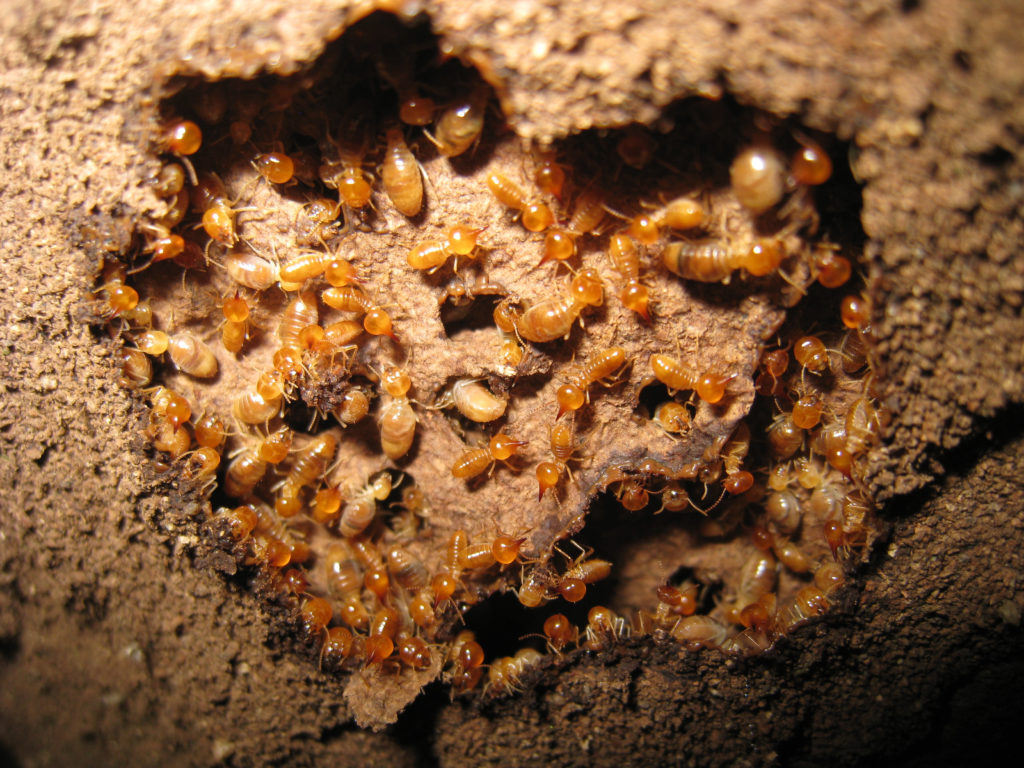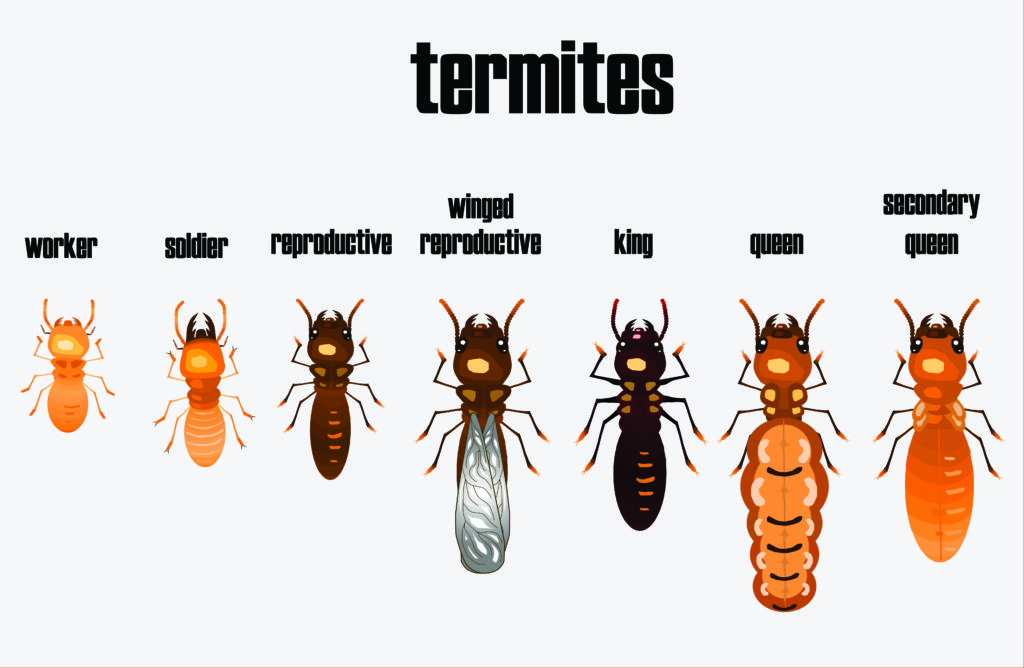What Do Baby Termites Look Like?

Baby termites, also known as larvae, look like small and pale adult termites.
Larvae go into a transition phase called molting.
Molting is an essential part of a baby termites’ life cycle.
During this phase, they shed their exoskeletons so their bodies can grow.
After several molts, larvae grow to assume a role in one of the termites’ caste: workers, soldiers, and reproductives.
At this stage, the larvae are now nymphs or juvenile termites.
Nymphs would continue to molt until it reaches adulthood.

How Big Are Baby Termites?
Baby termites are less than 2 mm long.
That is typically about half the size of a grain.
The worker termites feed and care for them until they grow into mature adult termites.
What do baby termites eat?
Baby termites eat cellulose.
Just like other termites, they get their cellulose mostly from wood.
The only difference is baby termites can’t digest the wood by themselves.
They need the help of worker termites to eat.
Reproductives can eat on their own they eventually begin relying on workers to fed them especially as their colonies begin growing.
Worker termites feed baby termites by breaking the cellulose down for them.
Baby termites do not gain the ability to eat wood unless they become an adult worker termite.
If they become an adult soldier, king, or queen, they will continue to rely on worker termite to eat.
Do baby Termites have wings?
Baby termites are not born with wings.
They may grow to assume the role of a reproductive.
In which case, the baby termite will grow wings once they become an adult.
Baby termites that do not develop wings become workers or soldiers.
Where do Baby Termites Live?

Baby termites live deep inside the termite nest.
Subterranean baby termites live 4 to 18 inches below ground.
Drywood baby termites stay concealed deep inside the wood.
They stay there until they molt into an adult ready to take on a role within the colony.
Can baby termites cause damage?
Baby termites cannot damage your home.
At least not until they grow into an adult.
Baby termites grow into assuming a role in one of the termites’ caste: workers, soldiers, and reproductives.
Workers damage your home by eating its structure from inside out.
Reproductives grow to produce more baby termites.
They are the future kings and queens. And their primary purpose is to start new colonies.
So, while baby termites may not damage your home immediately, they are certainly a threat.
How to get rid of Baby Termites?
To get rid of baby termites, you need to target the entire colony.
That’s because baby termites are located deep inside the nest.
For Subterranean termites, this is 4 to 18 inches below ground.
For Drywood termites, they’re somewhere concealed deep inside the wood.
For Dampwood termites, similar to drywood termites they are concealed deep inside the wood.
This is typically located near a source of moisture, or with wood that is in direct contact with soil.
You can target Drywood termites with localized treatment if you have a small infestation. If you have a significant infestation, you’ll need to do a Whole Structure treatment.
For subterranean termites, a combination of localized and soil treatment should be enough to eliminate the colony.
Finally, for Dampwood termites using a localized treatment, along with eliminating any moisture is the best way to eliminate a colony.
Frequently asked Questions (FAQ)
Where can you find termite eggs?
Termite eggs are hidden deep inside the nest.
After the queen lays the eggs, workers carry out the eggs to special incubation areas of the nest.
In smaller colonies, the eggs may be stored near the queen.
As the colony grows and the queen begins laying more eggs, the colony wil develop incubation areas within the nest for the eggs.
As such, you are unlikely to be able to find them.
What do termite eggs mean for your home?
Termite eggs are a clear sign that there’s a mature colony inside your home–and it’s expanding.
If you see termite eggs, take action immediately.
What do Termite Eggs look like?
Termite eggs look like white and brown caviar.
They are tiny and oval-shaped.
These eggs are typically clumped up in one area.
It is doubtful you will see these eggs since they are located deep inside the termite nest.
How many eggs do termites lay?
A queen can lay one egg every three seconds.
That averages to about 30,000 eggs per day.
And 10,950,000 eggs per year.
Queens can live for 50 years and can lay hundreds of millions of eggs in her lifetime.
How Long Does it Take for a Termite Egg to Hatch?
Termite eggs usually hatch after a month’s incubation.
But this will depend on the temperature.
Warmer temperatures help the eggs hatch faster.
Termite Eggs vs. Ant Eggs
Ant eggs are about 0.5 mm in diameter.
They are oval-shaped and white or transparent in color.
Termite eggs look like white and brown caviar.
They are tiny and oval-shaped.
Ants eggs hatch within two weeks of the incubation period.
In contrast, termite eggs need about a month to hatch.
What is an immature termite?
Immature termites are termites that are in the larvae and nymph stages.
They look the same as adults termite, only smaller.
Do all Immature termites look the same?
Yes.
All immature termites look the same until they molt to assume a role in the termite caste.
Once they assume a role, they grow features critical to that role.
If they grow to be soldiers, they will develop large mandibles to protect their nest from intruders.
If they grow to be reproductives, they will develop wings. These wings will allow them to leave the nest and start a new colony.
What do adult termite look like?

Baby termites grow to assume a role in one of the termites’ caste: workers, soldiers, and reproductives.
Here’s how they look like:
- Worker
Workers termites look like larvae.
Their bodies are soft, pale, and are the smallest of the castes.
The workers’ primary role is to build the nest and gather food for the other termites.
- Soldier
Soldier termites are typically bigger than workers.
They have dark-colored heads and large mandibles.
Their bodies vary in color depending on the species of termite.
Subterranean soldiers termite have a pale, cream-colored body.
Drywood termites soldiers have a light-brown body.
And Dampwood termites soldiers have a creamy-white to brown bodies.
These soldiers’ primary duty is to defend the nest from intruders. Their ancient rivals are ants.
- Reproductives or Swarmers
Reproductives have straight antennae and two pairs of translucent wings.
Both the front and back pairs of wings are equal in length and twice as long as their bodies.
Reproductives are the only type of termite that has wings.
They use their wings to leave the nest and start new colonies.
The reproductives’ primary purpose is to reproduce. They are the future kings and queens of termite colonies.
How to Prevent Termites?
- Properly Store your Firewood
Termites thrive on firewood, so make sure to keep them at least 20 feet from your home.
It’s also a good idea to keep firewood a few inches off the ground.
- Bug Screens
Also, another easy fix is to install bug screens over attic vents to prevent entry.
- Ventilate Properly
Ventilate your home to prevent them from becoming too humid.
Termites need a water source to survive. And they flourish in damp and moist areas.
Apply ventilation fans in your attic, basement, and crawl space.
- Replace All Damaged or Rotting Wood.
Termites thrive on rotten wood.
To keep them from coming back, remove all damaged wood. Make sure to replace it with wood that’s treated with pesticides.
- Maintain Landscape
Remove all plants and mulch away from the foundation of your home.
Also, limit any direct contact that wood has with soil around your home.
What Are the Signs of a termite infestation?
Termite infestations are hard to spot unless you know what to look for.
Here’s are common signs of termite infestation:
- Flying Termites or Swarmers
Flying termites signify a termite population is ready to expand into new colonies.
- Mud Tubes
Mud tubes could be a sign of subterranean termites.
A mud tube is made of small pieces of soil and wood.
These tubes help protect termites from predators.
They also protect termites from dry environments when gathering food.
- Uneven or Bubbling Paint
Uneven or bubbling paint could be a sign of termite damage.
- Frass / Droppings
If you find a small pile of what looks like pellets inside or outside the home, it could be a sign termite infestation.
- Weird Noises
If you hear a quiet clicking sound coming from the walls, it could be a sign of termite infestation.
When worker termites eat your woodwork, they make noises.
You can typically hear them eating if you place your ear against your walls.
- Hollow Wood
Termites devour wood from the inside out, leaving a weak shell.
As such, when you knock on an area that has termite damage, it will sound hollow.
